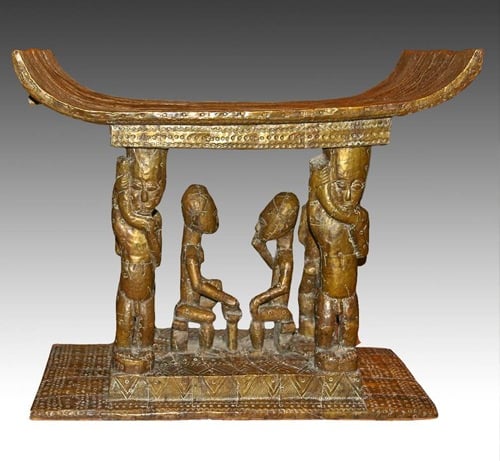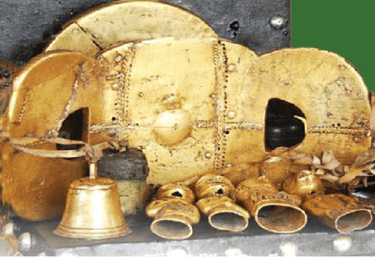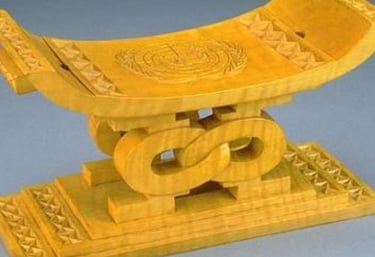The War of the Golden Stool (1900): A Symbol of Asante Resistance
The War of the Golden Stool, fought in 1900, stands as one of the most significant and symbolic conflicts in the history of the Asante Kingdom and British colonial Africa. This war was not merely a battle over territory or resources but was deeply rooted in the cultural and spiritual identity of the Asante people. It represented the struggle to defend the sanctity of their most sacred symbol, the Golden Stool, against British colonial imposition.
Alfred Rogol
8/15/20244 min read
The War of the Golden Stool (1900): A Symbol of Asante Resistance
The War of the Golden Stool, fought in 1900, stands as one of the most significant and symbolic conflicts in the history of the Asante Kingdom and British colonial Africa. This war was not merely a battle over territory or resources but was deeply rooted in the cultural and spiritual identity of the Asante people. It represented the struggle to defend the sanctity of their most sacred symbol, the Golden Stool, against British colonial imposition.
The Golden Stool: A Symbol of Asante Identity
The Golden Stool, known as the "Sika Dwa Kofi," is more than just a physical object to the Asante people; it embodies the soul and unity of the Asante nation. According to legend, the Golden Stool descended from the heavens and landed on the lap of Osei Tutu, the first Asantehene, signifying divine approval of his rule and the unification of the Asante states. The stool is believed to contain the spirit of the Asante people, linking the past, present, and future generations.
For the Asante, the Golden Stool was the most sacred symbol of their identity, sovereignty, and spiritual heritage. It was so revered that it was never allowed to touch the ground, and no one, including the Asantehene, was permitted to sit on it. The stool's importance transcended the individual and represented the collective essence of the Asante nation.
British Encroachment and Tensions
By the late 19th century, the British had established significant control over the coastal regions of present-day Ghana, known as the Gold Coast. However, the Asante Kingdom, located inland, remained a powerful and independent entity. Over the course of the century, a series of Anglo-Asante Wars had occurred, fuelled by British ambitions to extend their control and Asante resistance to foreign domination.
In 1896, after a series of military defeats, the British exiled the Asantehene, Prempeh I, and other Asante leaders to the Seychelles, effectively neutralizing the kingdom's political power. However, the British did not seize the Golden Stool, which remained hidden and protected by the Asante people.


The Catalyst: Governor Frederick Hodgson’s Demand
The War of the Golden Stool was ignited by a fateful event in March 1900. Sir Frederick Hodgson, the British Governor of the Gold Coast, made a highly provocative demand during a meeting with Asante chiefs in Kumasi. Hodgson insisted on being given the Golden Stool to sit on, as he believed it was the symbol of authority in the Asante Kingdom and, therefore, should be in British possession.
To the Asante, Hodgson's demand was not only an affront but a profound desecration of their most sacred symbol. The idea of a foreigner, especially a colonial ruler, sitting on the Golden Stool was unthinkable and intolerable. This demand was seen as an attempt to undermine the very essence of Asante sovereignty and cultural identity.
The Outbreak of War
The Asante response was swift and decisive. Led by Queen Mother Yaa Asantewaa of Ejisu, the Asante people rose in armed rebellion to protect the Golden Stool and resist British rule. Yaa Asantewaa, a formidable and courageous leader, rallied the Asante forces, famously declaring that if the men would not fight, the women would.
The war, also known as the Yaa Asantewaa War, saw fierce battles between the Asante forces and the British. The Asante used their knowledge of the local terrain to their advantage, engaging in guerrilla tactics and laying siege to the British fort in Kumasi. Despite being outgunned, the Asante showed remarkable resilience and determination.
The British, caught off guard by the intensity of the resistance, called in reinforcements from neighbouring colonies. After several months of fighting, the British eventually managed to break the siege and suppress the rebellion, but they never captured the Golden Stool. It was successfully hidden throughout the conflict, preserving its sacred status.


Aftermath and Legacy
The War of the Golden Stool marked the end of the Asante Kingdom’s independence, leading to its formal annexation into the British Gold Coast colony. The Asante people were subjected to British colonial rule, and the exiled Asantehene, Prempeh I, remained in captivity until his return in 1924.
However, the war also became a powerful symbol of resistance and pride for the Asante people. The successful defence of the Golden Stool, even in the face of overwhelming odds, underscored the deep cultural and spiritual resilience of the Asante nation. Yaa Asantewaa emerged as a national heroine, celebrated for her leadership and defiance against colonial oppression.
Today, the Golden Stool remains a potent symbol of Asante identity and continuity. The War of the Golden Stool is remembered not just as a military conflict but as a profound statement of cultural resistance and the enduring spirit of the Asante people. It serves as a reminder of the importance of preserving and defending cultural heritage in the face of external threats.

